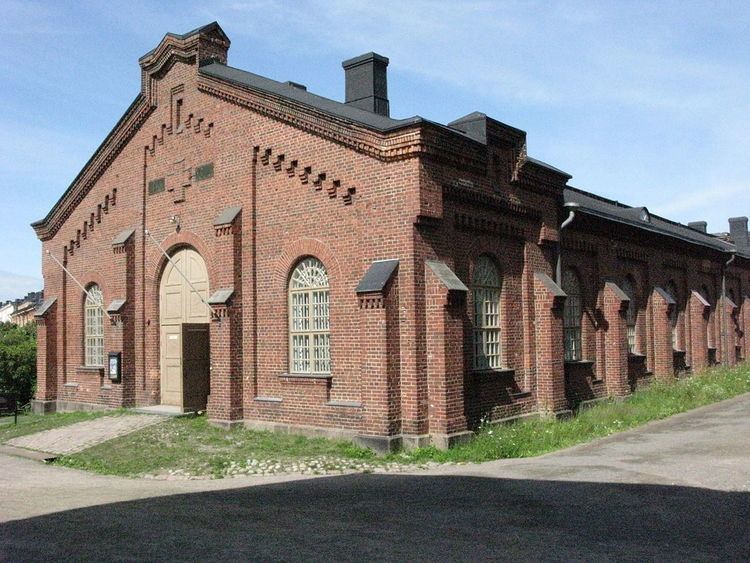Type Museum Completed 1881 Opened 1881 Inaugurated 1989 (as a Museum) | Location Helsinki, Finland Architect Greifon Phone +358 29 9530261 Construction started 1880 | |
 | ||
Address Iso Mustasaari c 77, 00190 Helsinki, Finland Hours Open today · 11AM–6PMWednesday11AM–6PMThursday11AM–6PMFriday11AM–6PMSaturday11AM–6PMSunday11AM–6PMMonday11AM–6PMTuesday11AM–6PMSuggest an edit Similar Finnish submarine Vesikko, Military Museum of Finland, Musée Ehrensvärd, Tullimuseo, Kuninkaanportti | ||
The Military Museum’s Manege, located in Suomenlinna sea fortress, is originally a Russian artillery storage built in 1880-1881. In 2012 a new exhibition From Autonomy to Atalanta was opened in the Manege. The new exhibition covers Finnish military history from early 19th century to the present day. Although most of the exhibition consists of World War II history, there is also some information about earlier centuries.
Contents
The building was opened as a museum in 1989 and there are approximately 13 000 visitors annually from all over the world. The museum is open 12.5.2012–31.10.2016 every day 11AM-6PM.
History of the Building
The Manege was built in 1880-1881, in a time when Finland was still part of the Russian Empire. Some architectural plans had been made already in 1875 but they were however rejected. Three years later architect Greifon’s plan was considered the best alternative. The Manege was built using brick and floor was originally made of clay. Floor was re-constructed however in 1908 by using concrete as building material. Between the entrances on both ends of the building is a large hall. Originally there were heating ovens next to the entrances.
Russians used the building mainly as artillery storage but there was also a possibility for soldiers to train gymnastics in the main hall. In the beginning of 1890s places for an orchestra, a stage and dressing rooms for both women and men were built in the end of the main hall. The Manege was suitable for many different purposes, but despite its name it was neved used as a riding hall.
After Finland gained its independence in 1917 the command of Suomenlinna sea fortress transferred from Russia to Finland. Soon after becoming independent Finland fell into Civil War. During and after the Civil War, Suomenlinna sea fortress had camps for red side´s prisoners of war. However, during the war the Manege served as storage and workshop. After the Civil War the Manege has primarily served as storage facility for the Finnish Navy and from 1974 onwards for the Military Museum. Anyhow, the main hall has occasionally served as a movie theatre and during the Continuation War it was also used as a basketball court.
The Manege was chosen to become a museum after The Military Museum received a permission from the government to open exhibitions again in Suomenlinna in 1975. Many residents of the sea fortress were suspicious about this at first because they feared the Military Museum would use residential buildings as exhibition space. The residents also feared that the Naval Museum, which had been closed in 1963, would be re-established in Suomenlinna. This however never occurred and the renovation of the Manege was carried out in 1986-1987. During the renovation, the heating ovens were removed and the floor was reconstructed.
There have been several different exhibitions during the years in the Manege and the ongoing From Autonomy to Atalanta-exhibition covers Finnish military history from early 19th century until the present day. The Military Museum has also arranged special exhibitions in the Manege, for example the Submarine Vesikko-exhibition in the summer of 2011.
From Autonomy to Atalanta- exhibition
From Autonomy to Atalanta-exhibition is situated in the main hall of the Manege. The exhibition consists of three parts: on the left side (looking from the main door) of the main hall is information about the Finnish military history and the development of Finnish Defence Forces. Different kinds of military uniforms from the 1800s until modern times are showcased on the right side of the main hall. In the middle visitors can explore bigger artifacts, such as missiles and cannons.
During the years the content of exhibitions has varied. However, a signal dugout and British Vickers-Armstrong tank, which was used in Winter and Continuation Wars, have been a permanent part of the exhibitions in the Manege. The artifacts on display in From Autonomy to Atalanta- exhibition vary in branch: anti-aircraft defense is represented with an RMB anti-aircraft gun, field artillery with a 76K/02 cannon and Navy with a Soviet T-46 torpedo and a Somali pirate boat which was taken over by minelayer Pohjanmaa during the Atalanta-operation. The relevance of supply in warfare is demonstrated with a field kitchen unit moved by horses, as well as with an American Ford V8-truck.
One of the exhibition´s rarities is the torpedo tube from a Finnish S2-torpedo boat. The tube has been in the bottom of the Baltic Sea twice. Originally the tube is from Imperial Russia´s torpedo boat Bditelnyi, which sank after hitting a sea mine in November 1917. The tube was then lifted from the sea by the Finnish army and put to a S2-torpedo boat, belonging to the Finnish Navy. In October 1925 the S2-torpedo boat faced a heavy storm and sank near Reposaari. The tube was again lifted up in the next year and it became a part of the Military Museum's collection in 1930.
